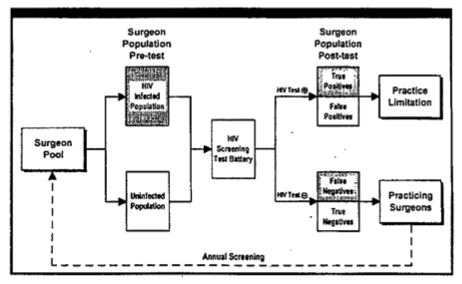
Screening Surgeons for HIV Infection: Assessment of a Potential Public Health Program
Abstract
Objective: To develop a model to assess the impact of a program of testing surgeons for human immunodeficiency virus (HIV) on the risk of HIV acquisition by their patients. Design: A Monte Carlo simulation model of physician-to-patient transmission of human immunodeficiency virus (HIV) infection using three different rates of physician-to-patient transmission per percutaneous exposure event (0.15%, 0.3%, 0.6%). Data from the odel were developed from a review of the medical literature and from subjective probability estimates when data were not available. We used this model to estimate on a national basis the annual number of cases of HIV transmission from surgeons to patients with and without surgeon testing and practice limitations. Results: The annual number of transmitted cases would range from 0.5 (+ or - 0.3), assuming a surgeon HIV prevalence of 0.1% and a surgeon-to-patient transmission rate of 0.15%, to 36.9 (+ or - 11.6), assuming a surgeon HIV prevalence of 2% and a surgeon-to-patient transmission rate of 0.6%. After one screening cycle, a mandatory screening program would be expected to reduce the annual transmissions to 0.05 (+ or - 0.03) and 3.1 (+ or - 1.1), respectively. Conclusion: Patients are at a low risk of acquiring HIV infection from an infected physician during an invasive procedure. The potential costs of such a program extended beyond the costs of testing and counseling. In communities with high HIV prevalence, screening surgeons and limiting their practices may decrease patient access to care. A disability insurance program also would be required to protect surgeons and trainees performing invasive procedures. Screening surgeons for HIV infection would be a costly undertaking that would reduce but not completely eliminate this risk.
Citation:
K.A. Schulman, R. McDonald, I. Frank, L.A. Lynn, N.A. Christakis, and J.S. Schwartz, "Screening Surgeons for HIV Infection: Assessment of a Potential Public Health Program" Infection Control and Hospital Epidemiology, 15(3): 147-155 (March 1994)